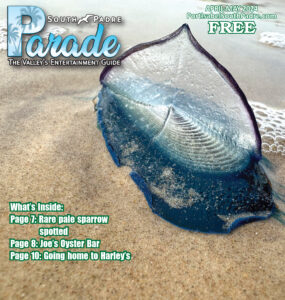By SCARLET COLLEY
Special to the Parade
Our friend Petra just returned from a two-week visit to South Georgia Island. Petra is not a stranger to South Padre as she is a trip leader for the three to four offshore birding trips we have yearly.
She is a birder extraordinaire. So when she was invited to go birding to see penguins and seabirds of the Sub-Antarctic, she was ecstatic and spent weeks preparing for it, purchasing the proper clothing and brushing up on her sea bird identification. To top it off, the author of Seabird Field Guide, Peter Harrison was going to be on the trip as one of the expedition leaders.
As she stepped on the vessel Sea Spirit in the port of Stanley, at the Falkland Islands, the spirit of adventure filled her very being. Just underway from the Port, all the 99 passengers on board were on the deck anxious to see their first penguins and seabirds. Kelp Gulls soared by, and Peter called out Magellanic Penguin, who were standing on the shore.
Petra’s binoculars where now glued to her face. She had not seen a penguin since her trip to the Galapagos in 2007. She knew there would be more species of penguins to see later in the trip. After two days at sea and crossing the Antarctic convergence zone, the Sea Spirit arrived at Elsehul Bay to be greeted by a shoreline covered with elephant seals at the height of pupping season, a Gentoo Penguin Colony, Giant Petrels and Brown Skuas, Snowy Sheathbills, and other species of birds.
A zodiac shuttled groups of 10 passengers to the shore. Petra wanted to see it all, and to capture the feeling of what the first explorers to set foot there must have felt of this pristine untouched island. The wildlife she encountered had no fear of her. The Gentoos were just building their nests and a few already sitting on eggs at this site.
Back on the Sea Spirit the meals were wonderful and the spirit of adventure, excitement and camaraderie ran high. The next site was Right Whale Bay, where one of the many King Penguin colonies resides. Here, Petra walked in awe of this social community that already had months-old babies calling to parents and parents to babies. The sounds of both Penguins and Elephant Seals were at times deafening.
The next stop was Salisbury Plain, where sadly Petra saw many of the King Penguin chicks lying dead from a recent early warm spell, causing their downy feathers to become soaked and leading to their death by hypothermia. Over a quarter of the chicks had died. The remaining chicks were healthy and being well taken care of by their doting parents. The couples who lost their babies had started to molt so they could begin a new breeding cycle. Their babies will be hatched earlier next year and therefore have a better chance of survival.
Little piles of ballast stones, which the Kings regurgitate when they start their molting seasons, laid around the colony grounds. The ballast stones are used to give them weight during their feeding times. Other penguin colonies that Petra had really wanted to observe, the Chinstraps and the Macaronis were located on the southern most shoreline, where the weather that day was too rough to make a landing. She wondered if she would miss those two species after such a long journey to get there.
Some of the nesting birds besides penguins on South Georgia were the amazing Gray-headed Albatross, Light-mantled Sooty Albatross and Wandering Albatross, all of which can live as long as humans. The Wandering Albatross has a wingspan of almost 12ft. Again, the birds had no fear of her as she photographed them on their nest sites.
After seven days of circumnavigating the entire South Georgia Island, Petra did get to see three Chinstrap Penguins in amongst the Gentoos on the beach. She was now only missing the Rockhoppers and Macaronis to complete her sightings of the species of penguins to be seen on this trip. Petra was amazed at the total absence of trash anywhere. For us who live on the Gulf of Mexico, that is quite a sight in itself.
So, I walk in the footsteps of her stories and memories of this amazing place at the bottom of the world. Did she see the last two species? Yes, on her return trip to the Falklands there were the Rockhoppers on Saunders Island and in amongst them, one Macaroni. Everybody high-fived and took a photo of him. It wasn’t Peter who found it, but one of the guides using his binoculars spotted this lone Macaroni in the crowd of Rockhoppers.
What an adventure, and to learn so much from Peter Harrison and the other guides and see an area so few humans get to see and return with 65 new species of birds on her bird list.
Petra will be planning her next adventure soon.



Comments